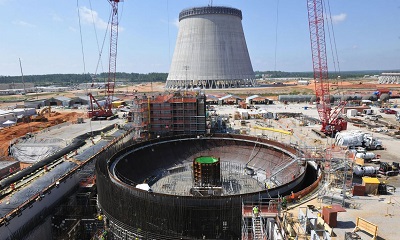New Nuclear Construction Around the World - ANS Annual Meeting 2016

Today's panel discussion entitled New Nuclear Construction Around the World and which was chaired by past ANS President Ted Quinn, featured some solid information on the state of nuclear energy today. Four speakers, plus one special guest speaker, presented to an interested and engaged audience.
Thomas O'Connor of the US Department of Energy led off, observing in his presentation "Actions to Support Advanced Reactor Development" that it is absolutely so expensive to perform nuclear research that "we cannot afford to do things twice," meaning that testing done today must provide information useful to those designing next-generation reactors and also useful to those attempting to design the regulations that will ensure the safety of such reactors. For that reason, DOE is coordinating efforts as much as possible to this end. O'Connor said that he believes that all types of nuclear power -- be it large light water reactors, light water small modular reactors (SMR's) or advanced non-light water reactors -- will be needed, and that today's investment in advanced reactors "ensures that safe, reliable energy in the many years to come."
As was the case today with several other speakers at other sessions, O'Connor made it very clear that the Department of Energy does not seek to designate technological winners and losers with its program. Instead, the focus is on facilitating investment in advanced nuclear technologies. O'Connor noted that several technologies are focused on, initially, for certain properties, however. For example, the high temperature gas cooled reactor is attractive because of its ability to provide process heat (for making chemicals, for example) and is a relatively mature technology, having been built commercially. He noted the sodium cooled fast reactor as being mature and significant from an actinide management standpoint, and also noted that "low maturity" technologies that needed a lot more work included the various molten salt designs and the lead cooled fast reactor concept.
Everett Redmond of the Nuclear Energy Institute was up next, covering the World Nuclear Energy Status and Outlook. Redmond told the assembled crowd that the overall, worldwide energy demand is presently expected to increase by 1/3 through the year 2040, but that the growth is entirely in non-OECD nations. In fact, he said that energy demand in the OECD nations is actually down at this time by 3% over last year. This means, then, that the majority of new nuclear builds will be outside the OECD nations.
Redmond's statistics showed that there are 445 reactors operating now in the world (not counting military units) and that the average age of these plants is roughly 30 years. In the United States, he said, the average plant age is 33 years; in the European Union, it's 29 years and in Russia it's 28 years. Simply put, he observed, "we must replace a very large number of reactors the world over by about 2050."
To that end, 63 reactors are under construction right now with 173 either on order or announced. (Redmond said that units which do not have a firm commitment are not included in this total.) This number is far short of what would be needed to replace retiring nuclear with new nuclear, he added.
On the lifetime extension front, Redmond noted the first two plants in the United States to apply for second license renewals out to 80 years have been announced (Surry, a Westinghouse PWR plant and Peach Bottom, a GE BWR plant). These and other potential extensions are offset somewhat by the premature shutdown of plants in the US, he said, for various reasons not related to physical condition (market forces, or in the case of Oyster Creek, policy problems in that the plant was facing the extremely expensive measure of having to install cooling towers to keep operating.) Redmond said that utilities must carefully consider these second license renewals, as "license renewal is easily a $2 billion investment overall, with a large amount of capital investment included in that."
The good news, he said, regarding nuclear new build was the fact that the Georgia Public Service Commission had allowed a 12% rate increase to cover costs of the new Vogtle 3 and 4 units but that latest figures show that only a 7% increase will actually be needed to pay for the units. Redmond did note that what delays have been encountered can be chalked up mostly to the atrophied nuclear supply chain in the United States.
In an interesting aside, Redmond observed that advanced reactors may actually allow utilities to increase their product range - noting that production of hydrogen fuels, or process heat for chemical plants could be things that utilities would consider important reasons to invest in advanced or Gen-IV reactors in the future if a market for these exists.
Jay Brister of AECOM and Art Wharton of Westinghouse rounded out the presentations, followed by an interesting Q&A session with the four panel members and Ted Quinn. A short presentation was made by Ann Winters, announcing her upcoming ANS book on the life of Admiral Eugene Wilkinson, famous first captain of the USS Nautilus and later first CEO of INPO. (The book is expected later this year.)
The session was highly informative, as is usually the case for this perennial panel session at ANS meetings, and many audience members stayed at the end to converse with the panel members. Thank you to Ted Quinn and Corey McDaniel for assembling this panel -- just one of the many varied and interesting presentations on this first day of the ANS Annual Meeting 2016.
Will Davis is reporting from the ANS Annual Meeting at the Hyatt Regency, New Orleans, Louisiana.

